Searsia gerrardii
Searsia gerrardii (Harv.ex Engl.) Moffett
Family: Anacardiaceae
Common names: river karee, river currant (Eng.), riviertaaibos (Afr.), inhlokoshiyane, umhlakaza (isiZulu)
SA Tree No: 378
Introduction
Searsia gerrardii is a shrub-like tree with a graceful, weeping habit, striking reddish bark and noticeable orange lenticels (raised pores) on the branchlets. In autumn, its leaves transform to a vivid red, complementing the shiny brown drupes that follow the spring blooms.
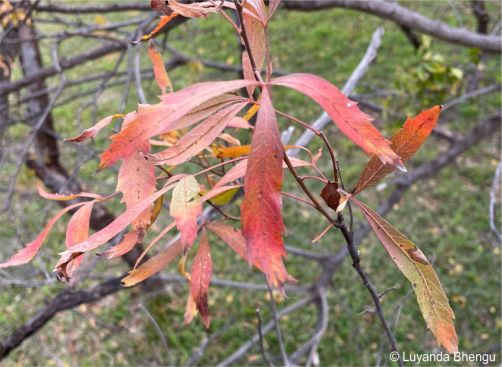
Description
Description
Searsia gerrardii is a small, deciduous, multi stemmed shrub or shrub-like tree that grows 2.5 to 5 m in height, older specimens often with drooping branches. The stem bark is reddish and granular. The branchlets are glabrous (hairless) or covered with woolly hairs and have noticeable orange lenticels (raised pores).
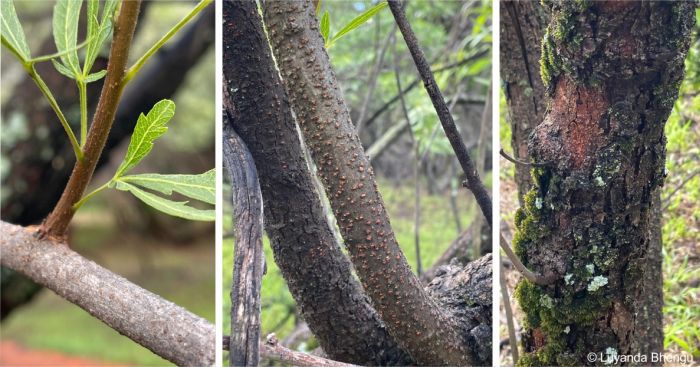
Searsia gerrardii has trifoliolate leaves that are 50–100 mm long, olive to dark green above, slightly paler below, and turning red in autumn. The leaflets are oblanceolate to narrowly elliptic , with a smooth to hairy surface. The leaflets have dull yellow veins that are prominent above. Margins are slightly wavy and sparsely and deeply toothed towards the tip, or entire (not toothed). Flowers are small, often clustered together tightly in compact, rounded panicles (sub-glomerulate), that are branched sparingly and are up to 90 mm long. Flowers bloom in late spring to summer and display a greenish yellow to cream colouration, with hairy calyx lobes. The fruits are small drupes (fleshy fruits with a hard seed inside), 3 mm in diameter, oblate (spherical with a flattened top and base), obloid (longer than broad with the broadest part above the middle), glabrous, shiny, green maturing light to dark brown.
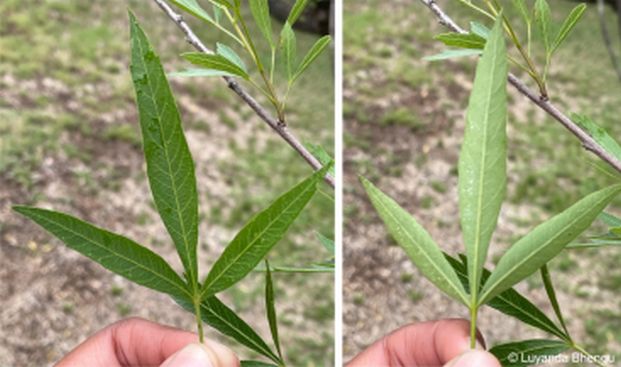
Conservation Status
Status
According to the Red List of South African Plants, this species is assessed as Least Concern (LC).
Distribution and habitat
Distribution description
Searsia gerrardii is endemic to southern Africa. Its native distribution includes South Africa, Eswatini and Lesotho. In South Africa it occurs in four provinces, namely Free State, Eastern Cape, Mpumalanga and KwaZulu-Natal, where it occurs at higher altitudes. It is predominantly found growing on the edges of perennial streams and on riverbanks, where it may form large thickets. It grows predominantly in the sub-tropical biome.

Derivation of name and historical aspects
History
Searsia gerrardii belongs to the mango family, Anacardiaceae. The genus Searsia has 120 species, the majority of which occur in Africa. The genus Searsia was previously known as Rhus. In 2001, a DNA study showed that Searsia is a separate group from Rhus, leading to its recognition as a distinct genus that represents the unique evolutionary history of Old World (Africa, Asia, Mediterranean region) species. This separation clarified the genetic and geographic differences between these related groups, confirming Searsia as a well-supported genus in plant classification. The genus was named in honour of Paul B. Sears (1891–1990). Species found under the genus Searsia can be easily identified by their compound trifoliolate leaves and dense, hard wood.
This species is named after William Tyrer Gerrard (1831-1866), an English naturalist, traveller, and collector of plants, birds and insects who, with M.J. McKen, was responsible for finding many new species in kwaZulu-Natal.
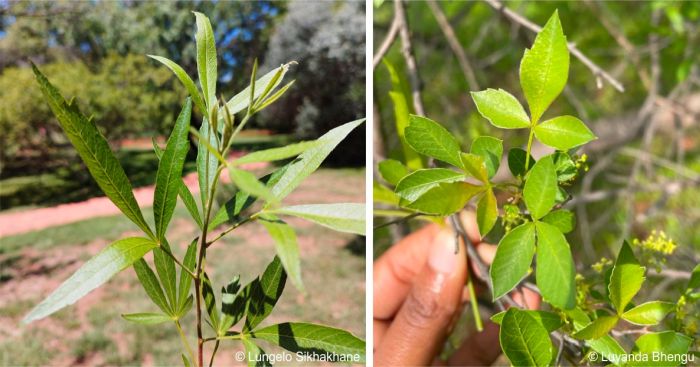
Ecology
Ecology
Searsia gerrardii has male and female flowers on separate plants (dioecious, meaning ‘two houses’), only the female plants bear fruits. The large bunches of fruits are a source of food for the birds. Due to its shrubby growth form, S. gerrardii provides shelter and nesting sites for birds, insects, and small mammals.
Uses
Use
Searsia gerrardii is used as an ornamental plant, it makes a beautiful addition to the garden with its drooping nature, and it is suitable to be grown in water-wise gardens and damp areas. It is friendly to wildlife, providing shelter and nesting sites for birds, the flowers will attract pollinators and beneficial insects to the garden and the fruits feed birds and insects, and people can also snack on them.
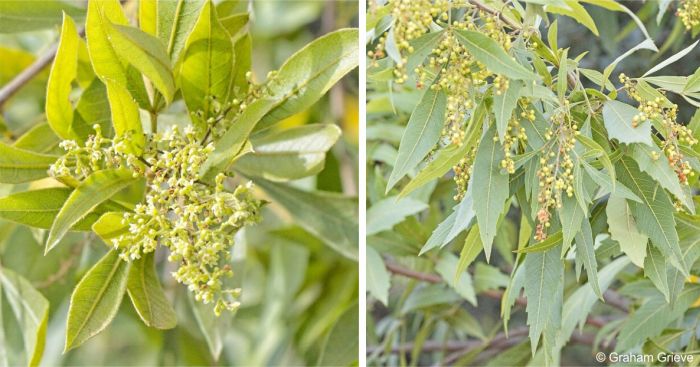
Growing Searsia gerrardii
Grow
Searsia gerrardii can be a good addition to small gardens by providing welcome shade. It is frost hardy, drought hardy, bird friendly and in autumn provides beautifully coloured foliage when the leaves turn burnt red. It grows best in semi-shade or full sun. The tree can also be grown beside rivers and streams.
To grow Searsia gerrardii from seeds, harvest mature fruits, clean them by rubbing off the outer parts, then sow them in spring or early summer, in a growing medium that combines equal parts coarse sand, compost, and loam soil, with no added artificial fertilizers. Mix the medium to create a well-drained, loose consistency.. Scatter the seeds lightly over the damp mixture, firm them down, and cover with coarse sand. Water well and place the seed tray in a cool, shady, well-ventilated area, keeping it moist, and out of direct sunlight during germination.
To propagate by cuttings, select semi-hardwood stems, treat with a suitable rooting hormone to encourage rooting and plant them in a moist, well-aerated soil mix. Place the cuttings in a well-ventilated area with indirect light.
References
- Boon, R. 2010. Pooley's trees of eastern South Africa, a complete guide. Flora & Fauna Publications Trust, Durban.
- Grieve, G. 2024-Mar. Observation of Searsia gerrardii, Amajuba District, KwaZulu-Natal. iNaturalist. Online. https://www.inaturalist.org/observations/204528896.
- Lifestyle Seeds. Searsia gerrardii (Rhus gerrardii). https://lifestyleseeds.co.za/shop/searsia-gerrardii-rhus-gerrardii/. Accessed 2024/11/25.
- Moffet, R.O. 1993. Rhus. Flora of southern Africa, vol. 19, Part 3, Fascicle 1. National Botanical Institute, Pretoria.
- Moffett, R.O. 2007. Name changes in the Old World Rhus and recognition of Searsia (Anacardiaceae). Bothalia 37(2):165–175.
- Raimondo, D., Von Staden, L., Foden, W., Victor, J.E., Helme, N.A., Turner, R.C., Kamundi, D.A. & Manyama, P.A. (eds) 2009. Red list of South African plants. Strelitzia 25. South African National Biodiversity Institute, Pretoria.
- Random Harvest Indigenous Nursery. Searsia gerrardii. https://www.randomharvest.co.za/South-African-Indigenous-Plants/Show-Plant/PlantId/94/Plant/Searsia-gerrardii?Filter=All. Accessed 2024/11/12.
- Welcome, A. & Van Wyk, B.-E. 2019. An inventory and analysis of the food plants of southern Africa. South African Journal of Botany 122: 136-179.
- Wentzel, J. n.d. Searsia gerrardii. Wildflower Nursery. Online. https://wildflowernursery.co.za/indigenous-plant-database/searsia-gerrardii/. Accessed 2024/11/20.
- World Flora Online. Searsia gerrardii. https://worldfloraonline.org/taxon/wfo-0000510241. Accessed 2024/11/03.
Credits
Luyanda Hlengiwe Bhengu and Lufuno Nenungwi
Free State National Botanical Garden
November 2024
Acknowledgements: the author thanks Lungelo Sikhakhane for assisting with editing and images, and Graham Grieve for making his images available via iNaturalist.
Plant Attributes:
Plant Type: Shrub, Tree
SA Distribution: Eastern Cape, Free State, KwaZulu-Natal, Mpumalanga
Soil type: Sandy, Loam
Flowering season: Early Summer, Late Summer
PH:
Flower colour: Cream
Aspect: Full Sun
Gardening skill: Average
Special Features:
Horticultural zones









Rate this article
Article well written and informative
Rate this plant
Is this an interesting plant?
Login to add your Comment
Back to topNot registered yet? Click here to register.